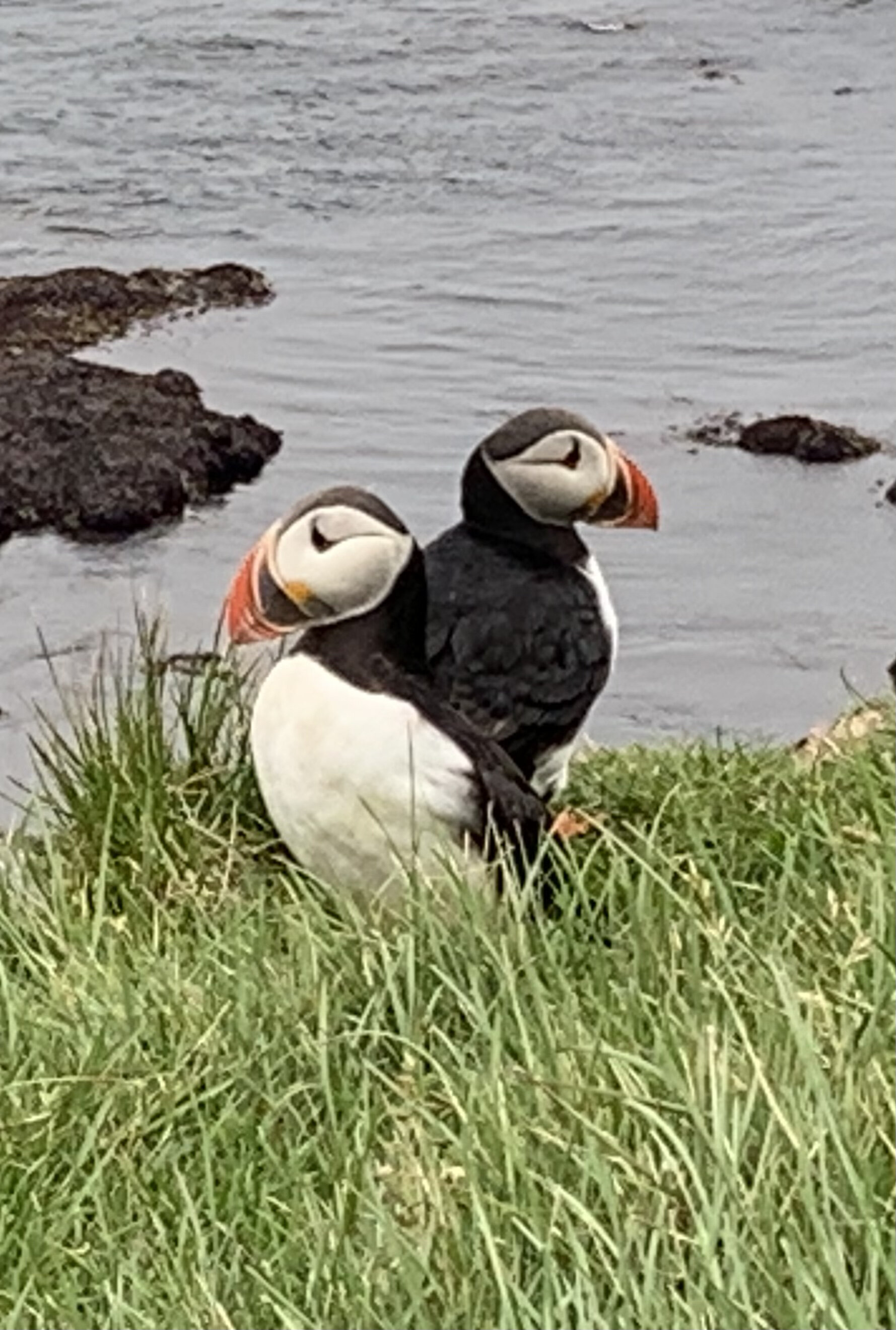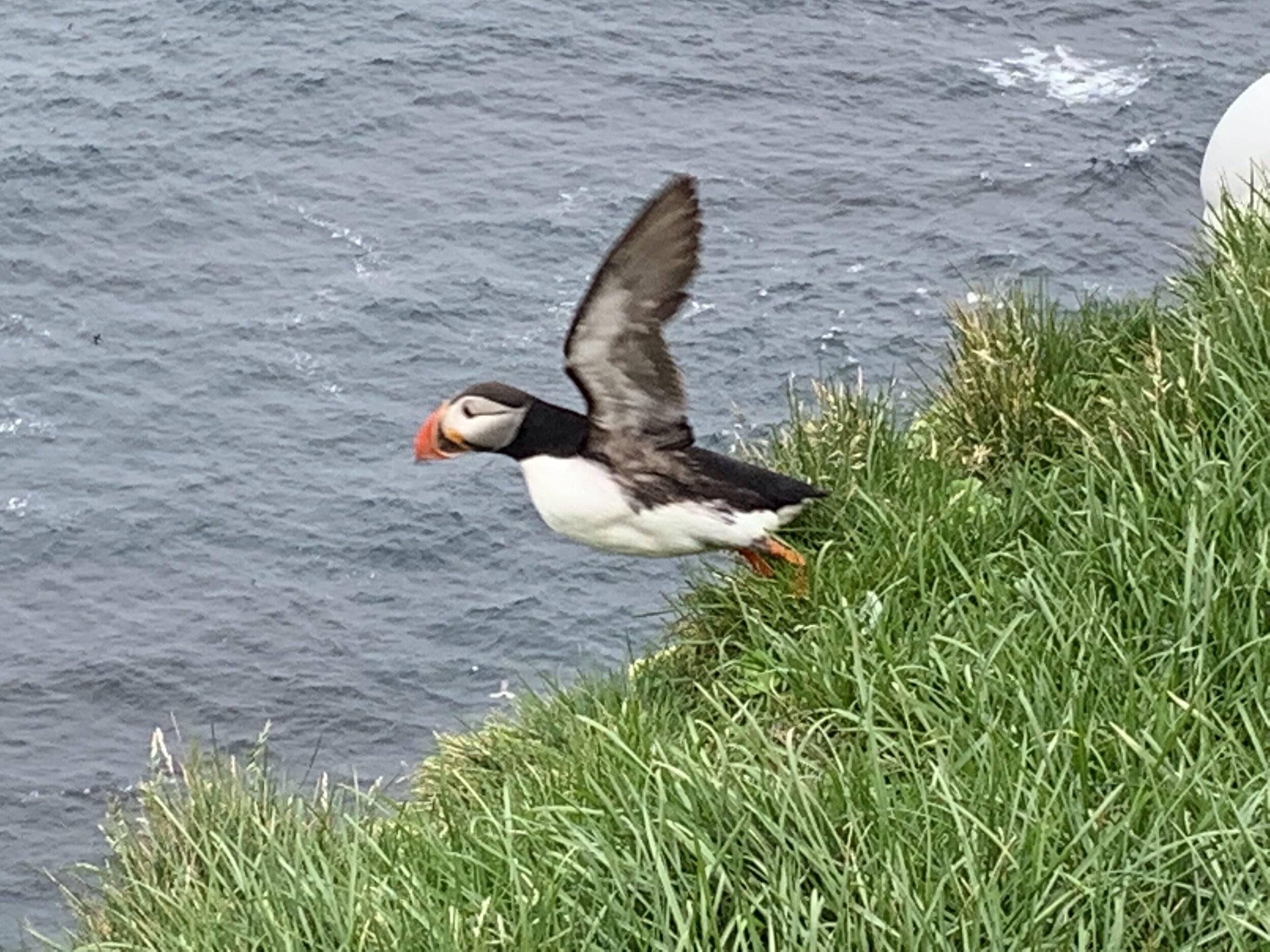Up close and personal with puffins!
A pair of puffins on the edge of the cliff
Many people associate Iceland with puffins - a fact that seems to rather mystify most Icelanders. Judging from the number of puffins you see in the tourist gift shops in Reykjavík you could be forgiven for thinking that the puffin is the national bird of Iceland. In fact the Icelandic national bird is the gyrfalcon which has been used in falconry for centuries and was an important part of Icelandic trade with wealthy Europeans as far back as the medieval era, being one of the country’s most prized exports.
However, back to the puffins. I have wanted to see them up close for such a long time - every guide book to Iceland, every article about the country seems to feature pictures of the funny little birds. They are nicknamed ‘clowns of the sea’ and it’s easy to see why. With their bright colours and funny, plump little bodies, along with their expression which looks terribly serious - even sad - they do look a little like clowns. And if you’ve ever seen a puffin trying to take off from the sea, splashing and flapping like crazy, you too have probably laughed at their antics, they just look so clumsy and improbable.
Puffin trying desperately to take off from the water
And yet puffins are pretty amazing creatures. They may not look too elegant in the air - even after the splashing and flapping of take-off, they don’t look particularly adept in the air - they seem to have to flap their wings nineteen to the dozen just to stay airborne - but they are pretty amazing under the water. Watching puffins bobbing about on the waves, it is common to see one suddenly disappear, and it can be absolutely ages before it comes up again. This is because puffins are the most amazing divers. A puffin can dive to a depth of 60m to catch fish - 60m!!!! I have achieved my deep diver scuba qualification and even so I am only allowed to dive to a depth of 40m, and that’s with the help of an oxygen tank on my back! But these little birds can plummet half as far again, catch their fish supper and shoot back up to the surface with no ill effects. Seeing them underwater, these plump ungainly little birds become sleek and fast and seem to be totally at home in this environment. Not only can they dive, swim and catch fish but they can hold more than 10 fish at a time in their beaks (although the record is apparently 62!!). ‘Clowns’ maybe, but not a bird to be underestimated.
One of my favourite puffins we saw - improbably fat and cute!
Although if I’m absolutely honest, the main reason I wanted to see puffins and photograph them up close is because they are just so darned cute! It’s almost impossible to see them and not smile. However, for months it seemed as if the Icelandic puffin was as elusive as in the wild as it is ubiquitous in the gift shops!! On our holiday in May we went to a number of the places known to be their regular haunts, but with no luck at all. Admittedly, it was a little early in the year as the nesting season tends to be from June to August, but I had expected to see at least one…. Perhaps because it had been a particularly cold spring in 2021 they were a little later arriving, I thought, but I was disappointed.
Roll on a few weeks and I had come out to work and to live in Iceland from Mid-June. Every weekend when Matthew asked where I wanted to go, I would pick a place where I might see puffins (he was very patient with my rapidly growing obsession!). And we did have a little more luck; on a trip to Reynisfjara near Vík we did indeed see lots of the little fellas bobbing about on the sea and taking off to land in their nesting spots up on the cliffs. We took a drive up to the bird sanctuary at Dyrholaey (one of the places mentioned in all the guidebooks as a pretty much guaranteed spot to see puffins) and from the cliff tops we were lucky enough to watch lots of them flying into their holes in the cliffs and sitting outside their burrows before taking off again to head back out to sea. We had a lovely morning watching them, but there was still a little niggling disappointment that I hadn’t been able to get close enough to properly photograph them. The pictures I had managed to get showed little more than black dots in the distance.
Hundreds of puffins bobbing about on the water, looking for lunch
So when we got the chance to take a few days break before heading back to the UK at the end of July we decided to spend some time in the Westfjords. Not only for puffins I hasten to add - the Westfjords has been on my to-do list for ages - but I have to admit the opportunity to see puffins in one of their most famous habitats was an added bonus. Do check out my other blog post The Westfjords of Iceland to find out more about the Westfjords themselves, because they are absolutely stunningly beautiful. But here and now we are talking all things puffin! I had heard that one of the very best places in Iceland to see these little birds was the Látrabjarg Cliffs which are at the westernmost point of the Fjords. For some reason, the birds there do not seem to be atop all afraid of people and so you stand a really good chance of getting good photographs. Why they are so unafraid at this particular habitat I don’t know. Perhaps it’s because the cliffs they choose to make their home are so very high and so very steep that they sense they are safe from human predators. Perhaps it’s simply because relatively few people make their way that far north and west…. On an average holiday in Iceland, there just isn’t enough time to get very far into the Westfjords as they are off the beaten track, away from the main ring road that allows access to most of Iceland’s tourist spots and even once into the fjords, the nature of the landscape and the winding roads that weave their way in and out of each fjord, hugging the coastline, means that it takes several hours to get to Látrabjarg. You kind of have to really want to see the amazing bird life there to bother making the trip.
So naturally, that was our destination on the first day of our fjords holiday! We had read that the best times to see the puffins were early morning and late afternoon into the evening so, as we had a long way to go, we decided we’d try for the evening. After a fabulous day admiring the incredible views as we meandered our way in and out of fjord after fjord, and a detour to the famous Red Beach at Rauðasandur we finally arrived at the Látrabjarg cliffs. Having parked up at the car park near the lighthouse we headed off on our puffin hunt. And it took all of three or four minutes before we were rewarded with the sight of dozens of the little birds, sitting happily on the edge of the huge vertical cliffs that they call home. As we had read, they were not in the least bit bothered by the people peering over the edge of the cliffs at them, even by the squeals of excitement as folks finally got their first proper sight of the little black and white birds. They really did not seem in the least bit afraid and happily sat posing for photograph after photograph like the most professional of models.
I have to say, the Látrabjarg Cliffs are an absolute paradise for birdwatchers and nature photographers. Not only puffins but razorbills, arctic terns and fulmars are there in abundance. At times the noise of seabirds was almost deafening. The place really is incredible. It is also incredibly high and incredibly steep! There are signs to warn people not to get too close to the edge and I wouldn’t recommend it to anyone who is afraid of heights, but if you want to get that photo you need to get fairly near to the edge (and that vertical drop!). Which is why I spent most of my time on my tummy, well away from the edge, then edging, inch by nervous inch, nearer to the precipice as Matthew capered about saying “quick, look, it’s just down there…. Quick, take a photo!” Honestly, that man seems to have no fear! I tell you, if it had just been a case of looking at the incredible views and the cliffs themselves, I’d have been quite happy to take a quick peek and then shoot back to a safe distance to say “Yep, fine, seen that done that!”. But the lure of the puffins outweighed even my fear and I finally got my much longed for close-up pictures.
Not for the faint-hearted. The figure at the end of the cliff shows the scale.
I don’t think I’ll ever tire of taking shots of these cute colourful birds!!
After such a long wait, it was so exciting to see the little birds in their own habitat, as they flew in and out of their burrows or just sat and watched the world go by. This place is just incredible. At times we were so close that had I wanted to, I could probably have reached out and touched one of them. I hasten to add I would never ever do that. It’s because the birds feel safe that they let us come so close, and touching their feathers would strip them of the natural oils they need to survive the life they lead so I would never do it, however tempting. It is enough to be that close to them and to be able to watch them. It was such an amazing privilege and one of my many Icelandic bucket list entries was finally ticked. As I write, the mating season is coming to an end and the puffins will head back out to sea and eventually to Canada and New England. And although it may well not now be until next summer I am already counting down the days to our next encounter.















